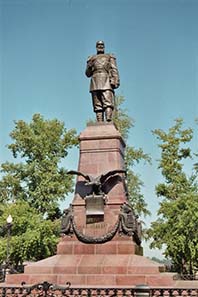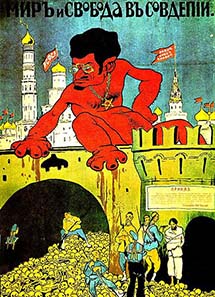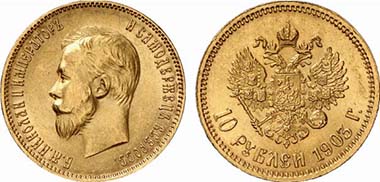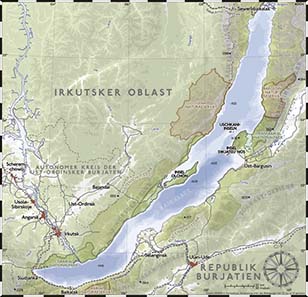by numiscontrol
Vanished mammon, tales, myths and treasure hunt without success
“Glorious Sea, the Sacred Baikal”, that is how the “Baikal hymn” written by Dimitrij Davydov starts. The lake is affectionately referred to as “Pearl of Siberia” since it is the world’s biggest freshwater reservoir. Lake Baikal is not big, it is huge: the surface of 31,500 square kilometers is roughly equivalent to the area of Belgium. At its deepest spot it is 1,637 meters to the ground and thereby it holds the world record. Depending on the time of the year, the lake appears majestically silent or has unpredictable storms to offer with waves up to five or six meters high. During wintertime, when temperatures drop as low as 60 degrees Celsius below zero, it freezes up. Then, it has become possible to drive over the surface by car. The 25 million year old lake can tell many stories – some of which it narrates willingly, others it keeps a secret in its depths.
Memorial of Tsar Alexander III
Since 2003 the bronze statue of Tsar Alexander III stands again in Irkutsk on the pedestal of the memorial that was put up in 1908. It reminds on the building of the Trans-Siberian Railway whose middle Siberian part ends there. In Irkutsk, the fabulous Circum-Baikal Railway starts off. In a wide circle it leads around the Southern part of the Lake Baikal to goes to Ulan-Ude. From there, the journey continues to Vladivostok or to Beijing.
Not far from Irkutsk the small village of Listvjanka is picturesquely situated near the Angara River. In winter 1919/1920, during the time of the Russian Civil War, White Guards attempted to get to Chita in their attempt to save the Tsar treasure and hence crossed over the Lake Baikal that was frozen over. The action fell through, in the literal sense. Up to the present day, the 650 million gold Roubles rest at the bottom of the lake. What happened? How did the gold get there?
Advertisement poster of the White Guards from 1919 showing a caricature of Trotzky / Wikipedia.
At the beginning of the First World War, the government had brought a large portion of the Tsar treasure to a seemingly safe haven in Kazan. There, it fell into the hands of the anti-communistic troops of the “White Guards” after the Civil War had started. They entrained the gold. Roughly 80 freight cars laden with gold coins are said to have embarked on their way to Irkutsk under the protection of the White Guards.
There, the transport was stopped by the Red Guards and Admiral Kolchak, leader of the White Guards, was shot dead. The White Guards, along with their precious cargo, frantically fought their way and fled towards Lake Baikal. With their freight cars, they reached Port Baikal on the lake’s South-West riverside. Due to the wintery climate, the lake was frozen over. During the short summer period, a ferry was in service to ferry travelers over to the East riverside, to Mysovaja / Babushkin. In winter, however, countless sleighs carried the passengers and their luggage. With heavy cargo, it was no different. As soon as the ice was thick enough, tracks were built to allow the freight cars to cross the lake. They were pulled by horses because the ice was unfit for heavy locomotives.
Russia, 10 Rouble 1903. From auction Künker 139 (2008), 8875.
To get the gold treasure as soon as possible to Chita, the commanders chose to cross over the ice. Apparently, locomotives derailed and caused the ice to break. Another story has it that soldiers froze to death on the ice during the transport of the freight cars. A sudden rise in temperature had caused the cargo to sink. Because of the bitter cold there were shanties, lined with felt, set every six kilometers to warm.
Be that as it may, it is hard to reconstruct what exactly happened on the lake. Eye witnesses, however, corroborate the most possible belief: due to thaw, the ice simply broke under the heavy freight cars. Only a fraction of the 180 tons of gold, packed in 5,100 cases and 1,600 bags, was rescued. 22 cases turned up again in Japan, 94 tons of gold made their – unexplained – way via Germany to France.
Interesting and hard to believe is the view that during the time of the Soviet Union nobody cared about the treasure in Lake Baikal and only today interest is arousing again.
Map of Lake Baikal / Wikipedia.
In 2008, search operations were started. Reportedly, scientific research had priority, for which two special submersible vessels were put to use 300 meters deep. They found nothing more than some boxes with cartridges from the time of the Civil War.
The search continued even when autumn storms churned up the waves of Lake Baikal up to six meters. Finally, a find was made 700 meters deep: heavily deformed freight cars were discovered from which some fragments were taken to the surface.
Studies confirmed the right date – whether they contained the lost gold remained a mystery for the time being. Further investigations were impossible due to the weather conditions. The expedition was broken off.
Freight cars on the bottom of Lake Baikal, however, are no single occurrence. Already in 1904, during the war with Japan, tracks were built on the frozen lake to guarantee a quick transport of artillery and ammunition. The route over the ice was in service from February 28th to March 25th back then. The freight cars were pulled over the ice by horses, too. Disassembled locomotives were taken to the opposite riverside. During that relatively short period of time, at least 60 locomotives and 2,300 freight cars were transported over the lake. Accidents and parts of the trains being sunk are reported.
Hence, nothing is known for sure and the tale of the sunken Tsar gold is rekindled again.
“Glorious Sea, the Sacred Baikal.”







